Leadership and Change: Report on Styles and Practices
VerifiedAdded on 2023/01/10
|9
|2394
|28
Report
AI Summary
This report delves into the realm of leadership, exploring various styles and approaches to guide employees towards achieving organizational goals. It primarily focuses on two prominent leadership models: authentic and ethical leadership. The report provides a comprehensive literature review, defining and conceptualizing these leadership styles, while also analyzing their strengths and weaknesses. Real-world examples are incorporated to illustrate the practical application of these styles. The report concludes by assessing the significance and practicality of each leadership approach in the context of corporate sector organizations, offering valuable insights for effective leadership practices.

LEADERSHIP AND
CHANGE
CHANGE
Paraphrase This Document
Need a fresh take? Get an instant paraphrase of this document with our AI Paraphraser
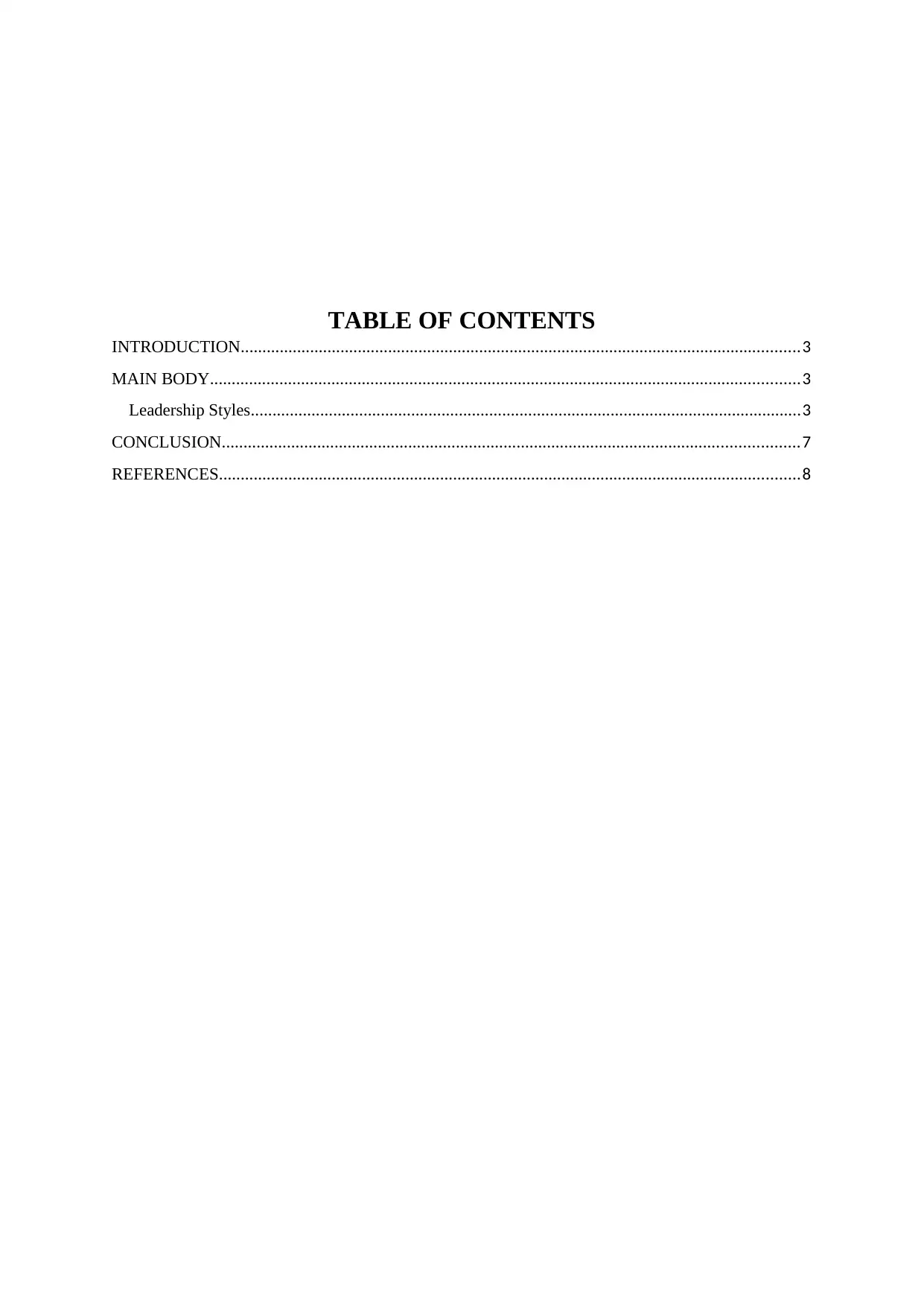
TABLE OF CONTENTS
INTRODUCTION.................................................................................................................................3
MAIN BODY........................................................................................................................................3
Leadership Styles...............................................................................................................................3
CONCLUSION.....................................................................................................................................7
REFERENCES......................................................................................................................................8
INTRODUCTION.................................................................................................................................3
MAIN BODY........................................................................................................................................3
Leadership Styles...............................................................................................................................3
CONCLUSION.....................................................................................................................................7
REFERENCES......................................................................................................................................8
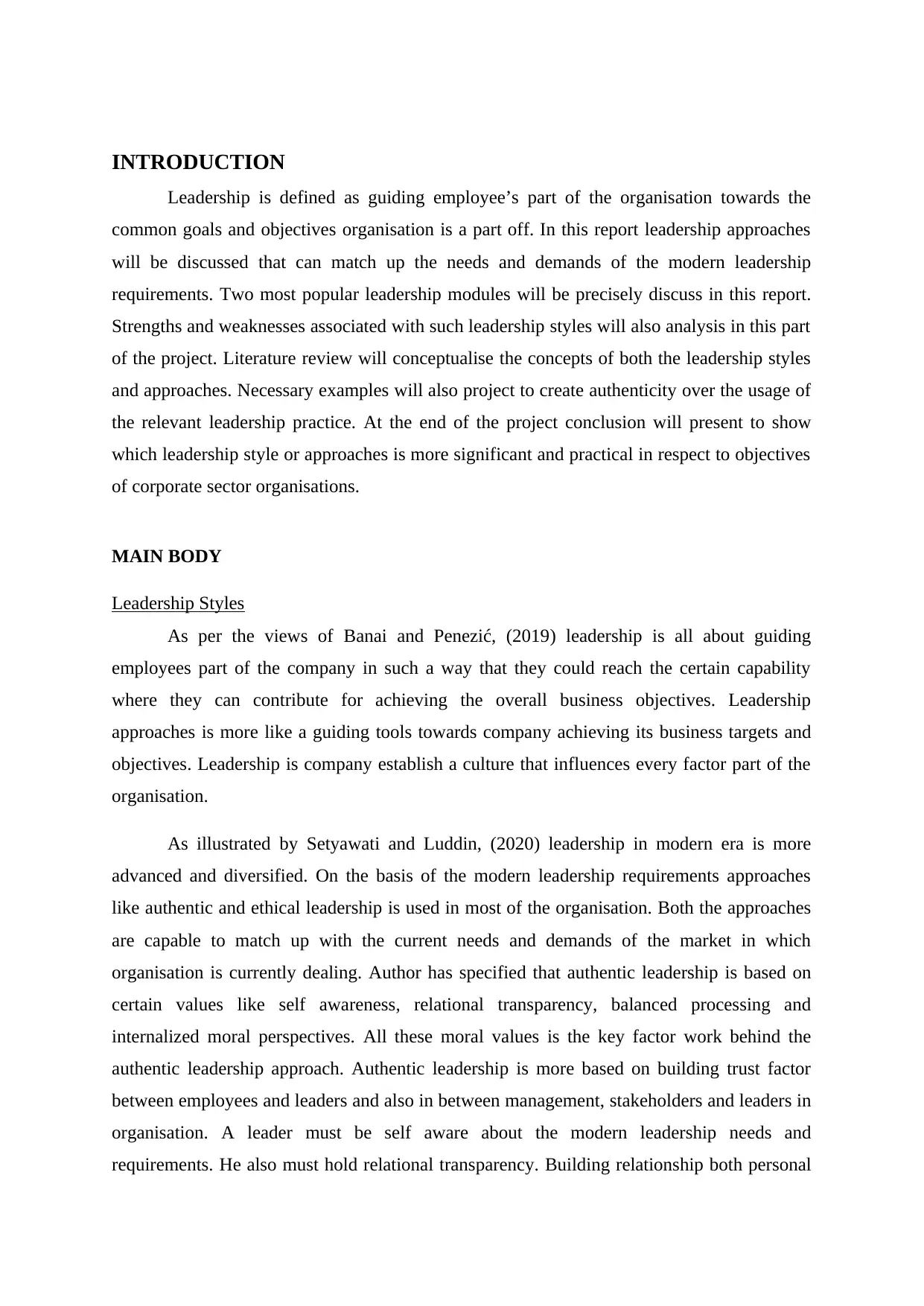
INTRODUCTION
Leadership is defined as guiding employee’s part of the organisation towards the
common goals and objectives organisation is a part off. In this report leadership approaches
will be discussed that can match up the needs and demands of the modern leadership
requirements. Two most popular leadership modules will be precisely discuss in this report.
Strengths and weaknesses associated with such leadership styles will also analysis in this part
of the project. Literature review will conceptualise the concepts of both the leadership styles
and approaches. Necessary examples will also project to create authenticity over the usage of
the relevant leadership practice. At the end of the project conclusion will present to show
which leadership style or approaches is more significant and practical in respect to objectives
of corporate sector organisations.
MAIN BODY
Leadership Styles
As per the views of Banai and Penezić, (2019) leadership is all about guiding
employees part of the company in such a way that they could reach the certain capability
where they can contribute for achieving the overall business objectives. Leadership
approaches is more like a guiding tools towards company achieving its business targets and
objectives. Leadership is company establish a culture that influences every factor part of the
organisation.
As illustrated by Setyawati and Luddin, (2020) leadership in modern era is more
advanced and diversified. On the basis of the modern leadership requirements approaches
like authentic and ethical leadership is used in most of the organisation. Both the approaches
are capable to match up with the current needs and demands of the market in which
organisation is currently dealing. Author has specified that authentic leadership is based on
certain values like self awareness, relational transparency, balanced processing and
internalized moral perspectives. All these moral values is the key factor work behind the
authentic leadership approach. Authentic leadership is more based on building trust factor
between employees and leaders and also in between management, stakeholders and leaders in
organisation. A leader must be self aware about the modern leadership needs and
requirements. He also must hold relational transparency. Building relationship both personal
Leadership is defined as guiding employee’s part of the organisation towards the
common goals and objectives organisation is a part off. In this report leadership approaches
will be discussed that can match up the needs and demands of the modern leadership
requirements. Two most popular leadership modules will be precisely discuss in this report.
Strengths and weaknesses associated with such leadership styles will also analysis in this part
of the project. Literature review will conceptualise the concepts of both the leadership styles
and approaches. Necessary examples will also project to create authenticity over the usage of
the relevant leadership practice. At the end of the project conclusion will present to show
which leadership style or approaches is more significant and practical in respect to objectives
of corporate sector organisations.
MAIN BODY
Leadership Styles
As per the views of Banai and Penezić, (2019) leadership is all about guiding
employees part of the company in such a way that they could reach the certain capability
where they can contribute for achieving the overall business objectives. Leadership
approaches is more like a guiding tools towards company achieving its business targets and
objectives. Leadership is company establish a culture that influences every factor part of the
organisation.
As illustrated by Setyawati and Luddin, (2020) leadership in modern era is more
advanced and diversified. On the basis of the modern leadership requirements approaches
like authentic and ethical leadership is used in most of the organisation. Both the approaches
are capable to match up with the current needs and demands of the market in which
organisation is currently dealing. Author has specified that authentic leadership is based on
certain values like self awareness, relational transparency, balanced processing and
internalized moral perspectives. All these moral values is the key factor work behind the
authentic leadership approach. Authentic leadership is more based on building trust factor
between employees and leaders and also in between management, stakeholders and leaders in
organisation. A leader must be self aware about the modern leadership needs and
requirements. He also must hold relational transparency. Building relationship both personal
⊘ This is a preview!⊘
Do you want full access?
Subscribe today to unlock all pages.

Trusted by 1+ million students worldwide
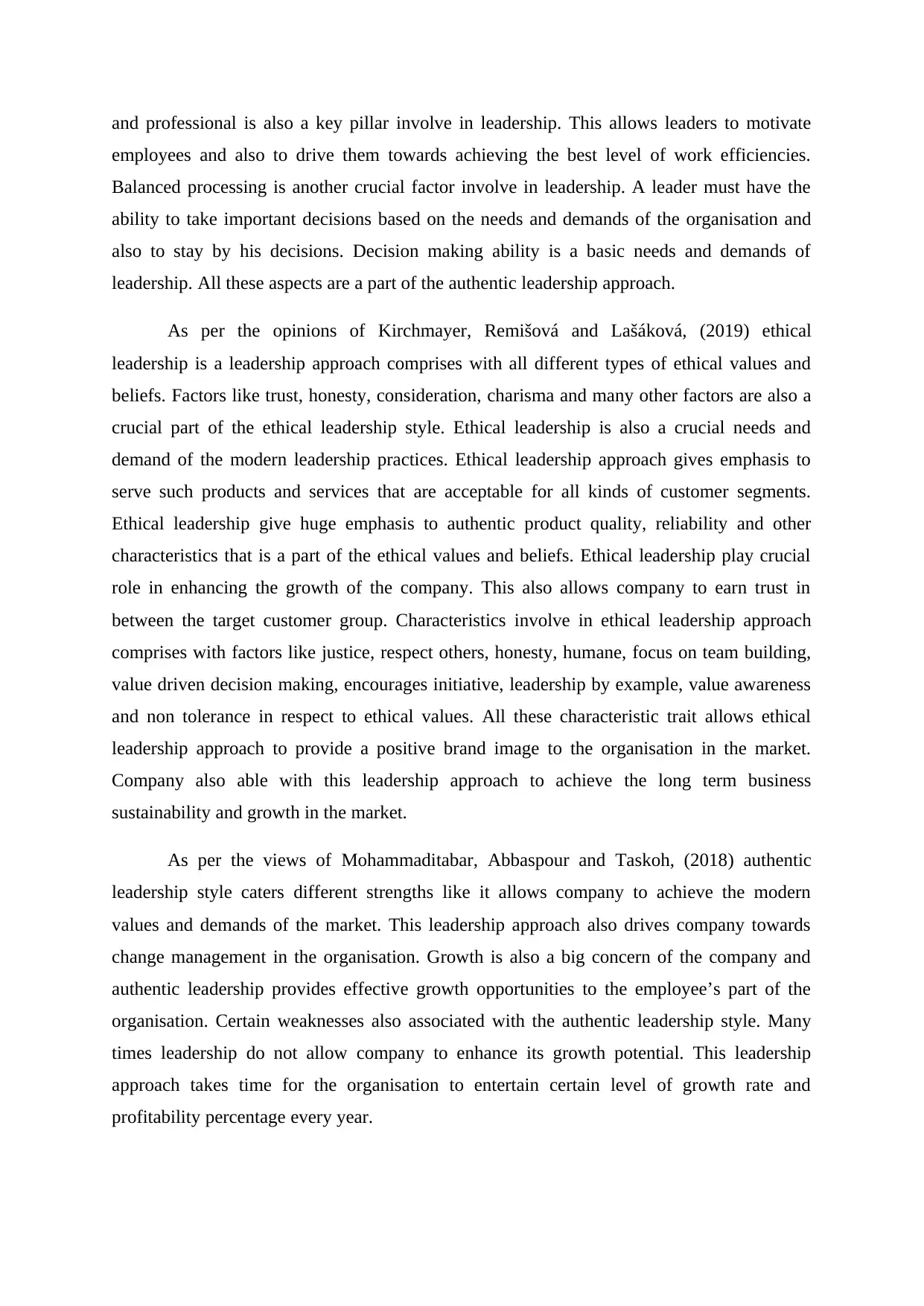
and professional is also a key pillar involve in leadership. This allows leaders to motivate
employees and also to drive them towards achieving the best level of work efficiencies.
Balanced processing is another crucial factor involve in leadership. A leader must have the
ability to take important decisions based on the needs and demands of the organisation and
also to stay by his decisions. Decision making ability is a basic needs and demands of
leadership. All these aspects are a part of the authentic leadership approach.
As per the opinions of Kirchmayer, Remišová and Lašáková, (2019) ethical
leadership is a leadership approach comprises with all different types of ethical values and
beliefs. Factors like trust, honesty, consideration, charisma and many other factors are also a
crucial part of the ethical leadership style. Ethical leadership is also a crucial needs and
demand of the modern leadership practices. Ethical leadership approach gives emphasis to
serve such products and services that are acceptable for all kinds of customer segments.
Ethical leadership give huge emphasis to authentic product quality, reliability and other
characteristics that is a part of the ethical values and beliefs. Ethical leadership play crucial
role in enhancing the growth of the company. This also allows company to earn trust in
between the target customer group. Characteristics involve in ethical leadership approach
comprises with factors like justice, respect others, honesty, humane, focus on team building,
value driven decision making, encourages initiative, leadership by example, value awareness
and non tolerance in respect to ethical values. All these characteristic trait allows ethical
leadership approach to provide a positive brand image to the organisation in the market.
Company also able with this leadership approach to achieve the long term business
sustainability and growth in the market.
As per the views of Mohammaditabar, Abbaspour and Taskoh, (2018) authentic
leadership style caters different strengths like it allows company to achieve the modern
values and demands of the market. This leadership approach also drives company towards
change management in the organisation. Growth is also a big concern of the company and
authentic leadership provides effective growth opportunities to the employee’s part of the
organisation. Certain weaknesses also associated with the authentic leadership style. Many
times leadership do not allow company to enhance its growth potential. This leadership
approach takes time for the organisation to entertain certain level of growth rate and
profitability percentage every year.
employees and also to drive them towards achieving the best level of work efficiencies.
Balanced processing is another crucial factor involve in leadership. A leader must have the
ability to take important decisions based on the needs and demands of the organisation and
also to stay by his decisions. Decision making ability is a basic needs and demands of
leadership. All these aspects are a part of the authentic leadership approach.
As per the opinions of Kirchmayer, Remišová and Lašáková, (2019) ethical
leadership is a leadership approach comprises with all different types of ethical values and
beliefs. Factors like trust, honesty, consideration, charisma and many other factors are also a
crucial part of the ethical leadership style. Ethical leadership is also a crucial needs and
demand of the modern leadership practices. Ethical leadership approach gives emphasis to
serve such products and services that are acceptable for all kinds of customer segments.
Ethical leadership give huge emphasis to authentic product quality, reliability and other
characteristics that is a part of the ethical values and beliefs. Ethical leadership play crucial
role in enhancing the growth of the company. This also allows company to earn trust in
between the target customer group. Characteristics involve in ethical leadership approach
comprises with factors like justice, respect others, honesty, humane, focus on team building,
value driven decision making, encourages initiative, leadership by example, value awareness
and non tolerance in respect to ethical values. All these characteristic trait allows ethical
leadership approach to provide a positive brand image to the organisation in the market.
Company also able with this leadership approach to achieve the long term business
sustainability and growth in the market.
As per the views of Mohammaditabar, Abbaspour and Taskoh, (2018) authentic
leadership style caters different strengths like it allows company to achieve the modern
values and demands of the market. This leadership approach also drives company towards
change management in the organisation. Growth is also a big concern of the company and
authentic leadership provides effective growth opportunities to the employee’s part of the
organisation. Certain weaknesses also associated with the authentic leadership style. Many
times leadership do not allow company to enhance its growth potential. This leadership
approach takes time for the organisation to entertain certain level of growth rate and
profitability percentage every year.
Paraphrase This Document
Need a fresh take? Get an instant paraphrase of this document with our AI Paraphraser
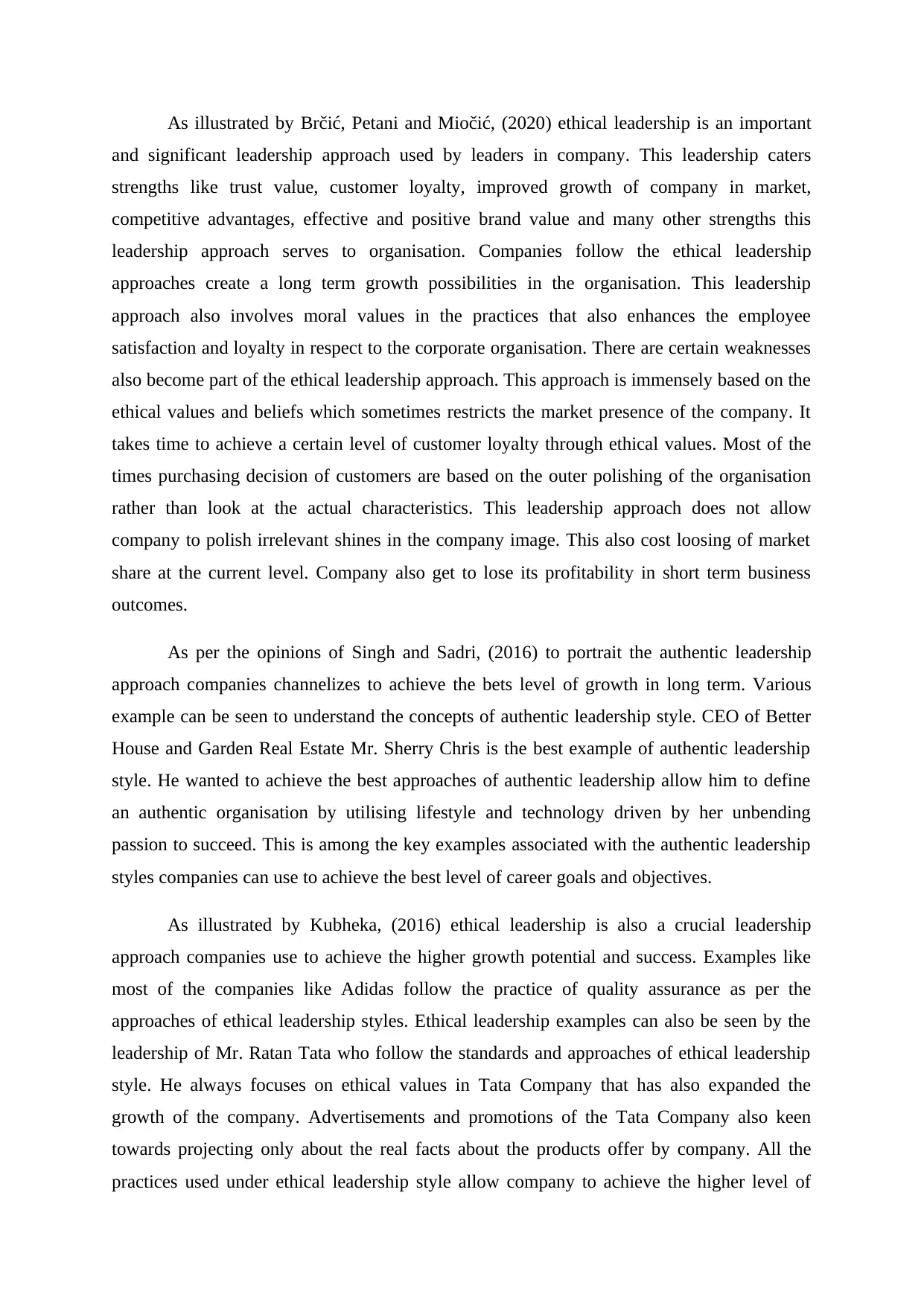
As illustrated by Brčić, Petani and Miočić, (2020) ethical leadership is an important
and significant leadership approach used by leaders in company. This leadership caters
strengths like trust value, customer loyalty, improved growth of company in market,
competitive advantages, effective and positive brand value and many other strengths this
leadership approach serves to organisation. Companies follow the ethical leadership
approaches create a long term growth possibilities in the organisation. This leadership
approach also involves moral values in the practices that also enhances the employee
satisfaction and loyalty in respect to the corporate organisation. There are certain weaknesses
also become part of the ethical leadership approach. This approach is immensely based on the
ethical values and beliefs which sometimes restricts the market presence of the company. It
takes time to achieve a certain level of customer loyalty through ethical values. Most of the
times purchasing decision of customers are based on the outer polishing of the organisation
rather than look at the actual characteristics. This leadership approach does not allow
company to polish irrelevant shines in the company image. This also cost loosing of market
share at the current level. Company also get to lose its profitability in short term business
outcomes.
As per the opinions of Singh and Sadri, (2016) to portrait the authentic leadership
approach companies channelizes to achieve the bets level of growth in long term. Various
example can be seen to understand the concepts of authentic leadership style. CEO of Better
House and Garden Real Estate Mr. Sherry Chris is the best example of authentic leadership
style. He wanted to achieve the best approaches of authentic leadership allow him to define
an authentic organisation by utilising lifestyle and technology driven by her unbending
passion to succeed. This is among the key examples associated with the authentic leadership
styles companies can use to achieve the best level of career goals and objectives.
As illustrated by Kubheka, (2016) ethical leadership is also a crucial leadership
approach companies use to achieve the higher growth potential and success. Examples like
most of the companies like Adidas follow the practice of quality assurance as per the
approaches of ethical leadership styles. Ethical leadership examples can also be seen by the
leadership of Mr. Ratan Tata who follow the standards and approaches of ethical leadership
style. He always focuses on ethical values in Tata Company that has also expanded the
growth of the company. Advertisements and promotions of the Tata Company also keen
towards projecting only about the real facts about the products offer by company. All the
practices used under ethical leadership style allow company to achieve the higher level of
and significant leadership approach used by leaders in company. This leadership caters
strengths like trust value, customer loyalty, improved growth of company in market,
competitive advantages, effective and positive brand value and many other strengths this
leadership approach serves to organisation. Companies follow the ethical leadership
approaches create a long term growth possibilities in the organisation. This leadership
approach also involves moral values in the practices that also enhances the employee
satisfaction and loyalty in respect to the corporate organisation. There are certain weaknesses
also become part of the ethical leadership approach. This approach is immensely based on the
ethical values and beliefs which sometimes restricts the market presence of the company. It
takes time to achieve a certain level of customer loyalty through ethical values. Most of the
times purchasing decision of customers are based on the outer polishing of the organisation
rather than look at the actual characteristics. This leadership approach does not allow
company to polish irrelevant shines in the company image. This also cost loosing of market
share at the current level. Company also get to lose its profitability in short term business
outcomes.
As per the opinions of Singh and Sadri, (2016) to portrait the authentic leadership
approach companies channelizes to achieve the bets level of growth in long term. Various
example can be seen to understand the concepts of authentic leadership style. CEO of Better
House and Garden Real Estate Mr. Sherry Chris is the best example of authentic leadership
style. He wanted to achieve the best approaches of authentic leadership allow him to define
an authentic organisation by utilising lifestyle and technology driven by her unbending
passion to succeed. This is among the key examples associated with the authentic leadership
styles companies can use to achieve the best level of career goals and objectives.
As illustrated by Kubheka, (2016) ethical leadership is also a crucial leadership
approach companies use to achieve the higher growth potential and success. Examples like
most of the companies like Adidas follow the practice of quality assurance as per the
approaches of ethical leadership styles. Ethical leadership examples can also be seen by the
leadership of Mr. Ratan Tata who follow the standards and approaches of ethical leadership
style. He always focuses on ethical values in Tata Company that has also expanded the
growth of the company. Advertisements and promotions of the Tata Company also keen
towards projecting only about the real facts about the products offer by company. All the
practices used under ethical leadership style allow company to achieve the higher level of
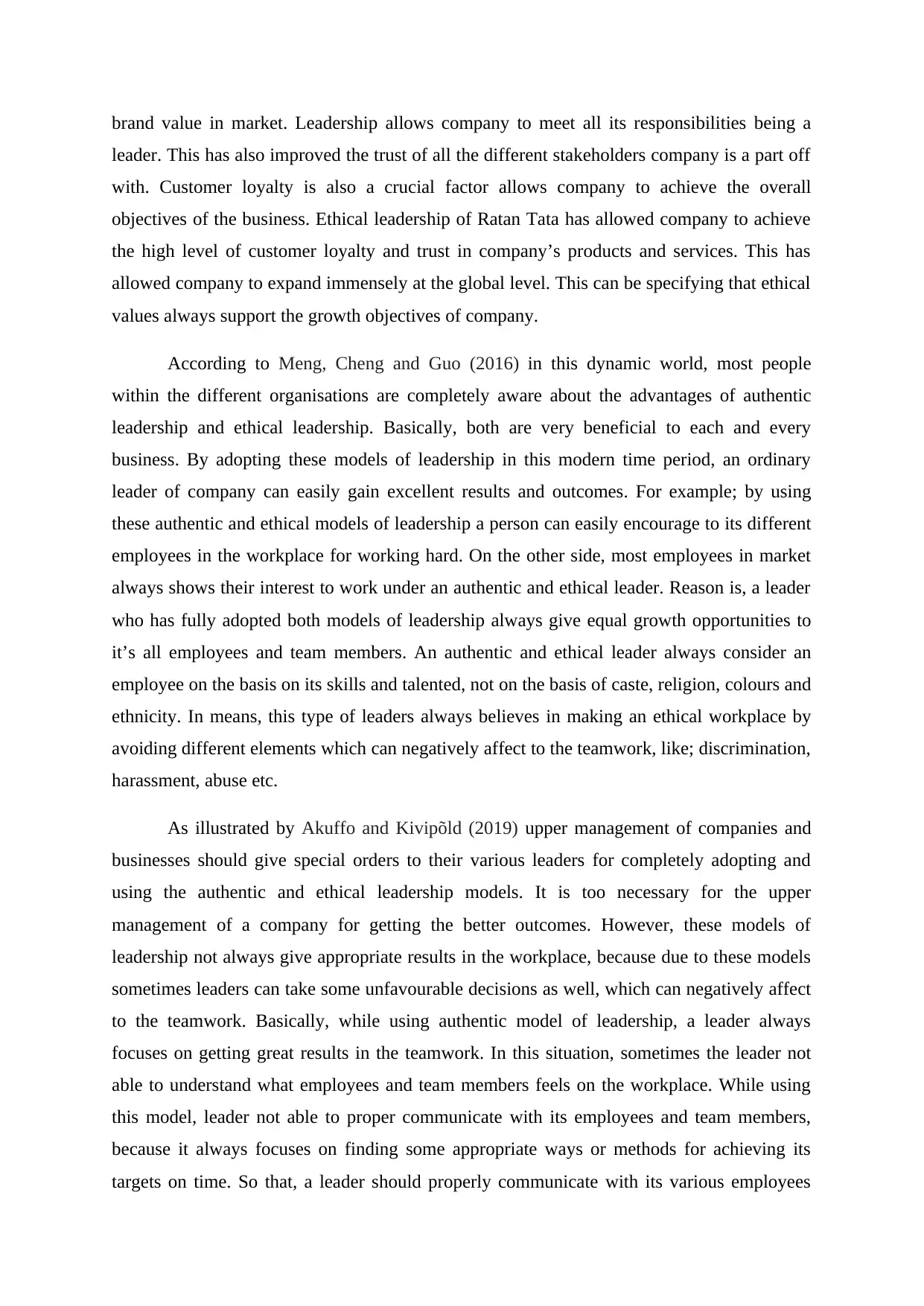
brand value in market. Leadership allows company to meet all its responsibilities being a
leader. This has also improved the trust of all the different stakeholders company is a part off
with. Customer loyalty is also a crucial factor allows company to achieve the overall
objectives of the business. Ethical leadership of Ratan Tata has allowed company to achieve
the high level of customer loyalty and trust in company’s products and services. This has
allowed company to expand immensely at the global level. This can be specifying that ethical
values always support the growth objectives of company.
According to Meng, Cheng and Guo (2016) in this dynamic world, most people
within the different organisations are completely aware about the advantages of authentic
leadership and ethical leadership. Basically, both are very beneficial to each and every
business. By adopting these models of leadership in this modern time period, an ordinary
leader of company can easily gain excellent results and outcomes. For example; by using
these authentic and ethical models of leadership a person can easily encourage to its different
employees in the workplace for working hard. On the other side, most employees in market
always shows their interest to work under an authentic and ethical leader. Reason is, a leader
who has fully adopted both models of leadership always give equal growth opportunities to
it’s all employees and team members. An authentic and ethical leader always consider an
employee on the basis on its skills and talented, not on the basis of caste, religion, colours and
ethnicity. In means, this type of leaders always believes in making an ethical workplace by
avoiding different elements which can negatively affect to the teamwork, like; discrimination,
harassment, abuse etc.
As illustrated by Akuffo and Kivipõld (2019) upper management of companies and
businesses should give special orders to their various leaders for completely adopting and
using the authentic and ethical leadership models. It is too necessary for the upper
management of a company for getting the better outcomes. However, these models of
leadership not always give appropriate results in the workplace, because due to these models
sometimes leaders can take some unfavourable decisions as well, which can negatively affect
to the teamwork. Basically, while using authentic model of leadership, a leader always
focuses on getting great results in the teamwork. In this situation, sometimes the leader not
able to understand what employees and team members feels on the workplace. While using
this model, leader not able to proper communicate with its employees and team members,
because it always focuses on finding some appropriate ways or methods for achieving its
targets on time. So that, a leader should properly communicate with its various employees
leader. This has also improved the trust of all the different stakeholders company is a part off
with. Customer loyalty is also a crucial factor allows company to achieve the overall
objectives of the business. Ethical leadership of Ratan Tata has allowed company to achieve
the high level of customer loyalty and trust in company’s products and services. This has
allowed company to expand immensely at the global level. This can be specifying that ethical
values always support the growth objectives of company.
According to Meng, Cheng and Guo (2016) in this dynamic world, most people
within the different organisations are completely aware about the advantages of authentic
leadership and ethical leadership. Basically, both are very beneficial to each and every
business. By adopting these models of leadership in this modern time period, an ordinary
leader of company can easily gain excellent results and outcomes. For example; by using
these authentic and ethical models of leadership a person can easily encourage to its different
employees in the workplace for working hard. On the other side, most employees in market
always shows their interest to work under an authentic and ethical leader. Reason is, a leader
who has fully adopted both models of leadership always give equal growth opportunities to
it’s all employees and team members. An authentic and ethical leader always consider an
employee on the basis on its skills and talented, not on the basis of caste, religion, colours and
ethnicity. In means, this type of leaders always believes in making an ethical workplace by
avoiding different elements which can negatively affect to the teamwork, like; discrimination,
harassment, abuse etc.
As illustrated by Akuffo and Kivipõld (2019) upper management of companies and
businesses should give special orders to their various leaders for completely adopting and
using the authentic and ethical leadership models. It is too necessary for the upper
management of a company for getting the better outcomes. However, these models of
leadership not always give appropriate results in the workplace, because due to these models
sometimes leaders can take some unfavourable decisions as well, which can negatively affect
to the teamwork. Basically, while using authentic model of leadership, a leader always
focuses on getting great results in the teamwork. In this situation, sometimes the leader not
able to understand what employees and team members feels on the workplace. While using
this model, leader not able to proper communicate with its employees and team members,
because it always focuses on finding some appropriate ways or methods for achieving its
targets on time. So that, a leader should properly communicate with its various employees
⊘ This is a preview!⊘
Do you want full access?
Subscribe today to unlock all pages.

Trusted by 1+ million students worldwide
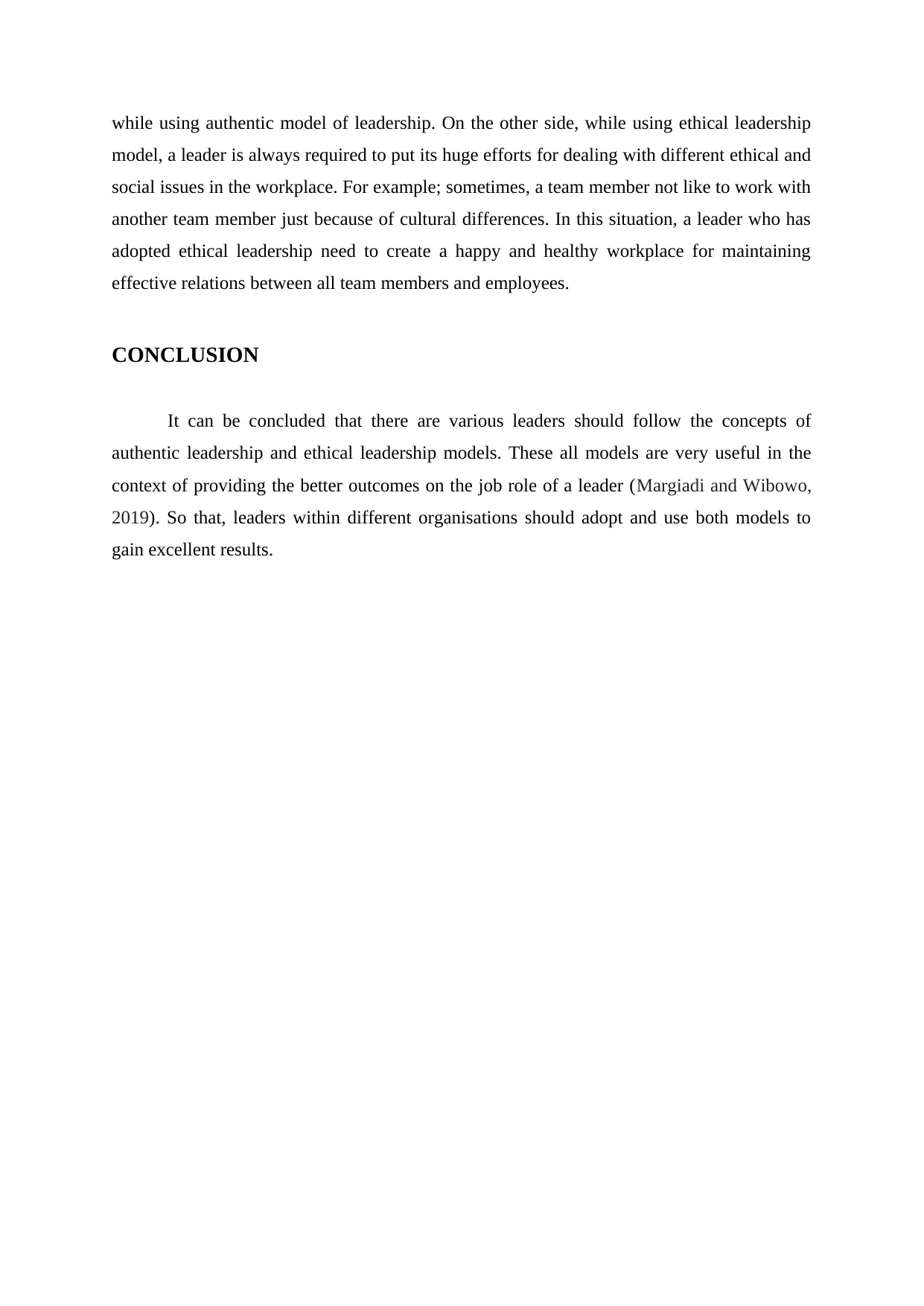
while using authentic model of leadership. On the other side, while using ethical leadership
model, a leader is always required to put its huge efforts for dealing with different ethical and
social issues in the workplace. For example; sometimes, a team member not like to work with
another team member just because of cultural differences. In this situation, a leader who has
adopted ethical leadership need to create a happy and healthy workplace for maintaining
effective relations between all team members and employees.
CONCLUSION
It can be concluded that there are various leaders should follow the concepts of
authentic leadership and ethical leadership models. These all models are very useful in the
context of providing the better outcomes on the job role of a leader (Margiadi and Wibowo,
2019). So that, leaders within different organisations should adopt and use both models to
gain excellent results.
model, a leader is always required to put its huge efforts for dealing with different ethical and
social issues in the workplace. For example; sometimes, a team member not like to work with
another team member just because of cultural differences. In this situation, a leader who has
adopted ethical leadership need to create a happy and healthy workplace for maintaining
effective relations between all team members and employees.
CONCLUSION
It can be concluded that there are various leaders should follow the concepts of
authentic leadership and ethical leadership models. These all models are very useful in the
context of providing the better outcomes on the job role of a leader (Margiadi and Wibowo,
2019). So that, leaders within different organisations should adopt and use both models to
gain excellent results.
Paraphrase This Document
Need a fresh take? Get an instant paraphrase of this document with our AI Paraphraser
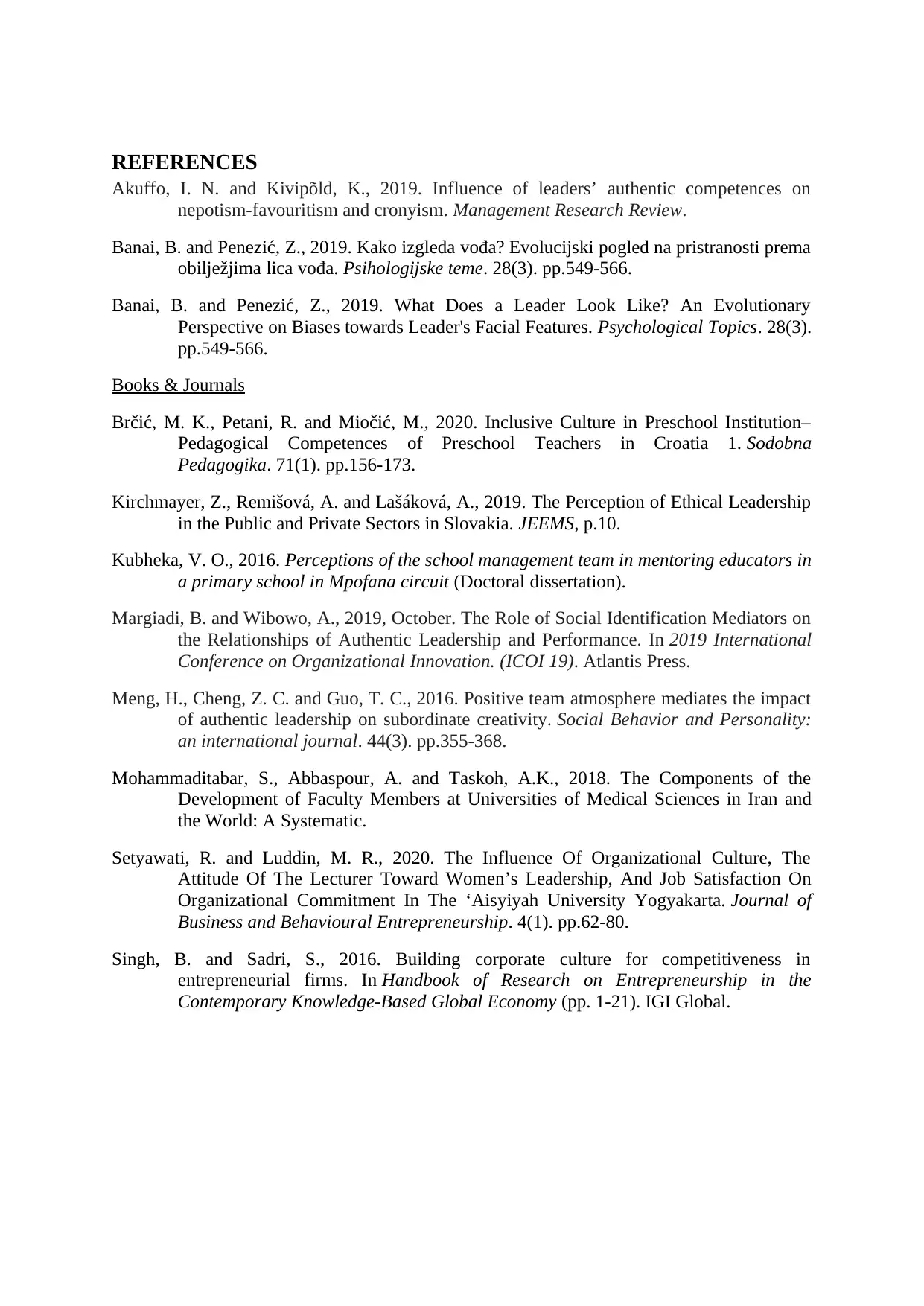
REFERENCES
Akuffo, I. N. and Kivipõld, K., 2019. Influence of leaders’ authentic competences on
nepotism-favouritism and cronyism. Management Research Review.
Banai, B. and Penezić, Z., 2019. Kako izgleda vođa? Evolucijski pogled na pristranosti prema
obilježjima lica vođa. Psihologijske teme. 28(3). pp.549-566.
Banai, B. and Penezić, Z., 2019. What Does a Leader Look Like? An Evolutionary
Perspective on Biases towards Leader's Facial Features. Psychological Topics. 28(3).
pp.549-566.
Books & Journals
Brčić, M. K., Petani, R. and Miočić, M., 2020. Inclusive Culture in Preschool Institution–
Pedagogical Competences of Preschool Teachers in Croatia 1. Sodobna
Pedagogika. 71(1). pp.156-173.
Kirchmayer, Z., Remišová, A. and Lašáková, A., 2019. The Perception of Ethical Leadership
in the Public and Private Sectors in Slovakia. JEEMS, p.10.
Kubheka, V. O., 2016. Perceptions of the school management team in mentoring educators in
a primary school in Mpofana circuit (Doctoral dissertation).
Margiadi, B. and Wibowo, A., 2019, October. The Role of Social Identification Mediators on
the Relationships of Authentic Leadership and Performance. In 2019 International
Conference on Organizational Innovation. (ICOI 19). Atlantis Press.
Meng, H., Cheng, Z. C. and Guo, T. C., 2016. Positive team atmosphere mediates the impact
of authentic leadership on subordinate creativity. Social Behavior and Personality:
an international journal. 44(3). pp.355-368.
Mohammaditabar, S., Abbaspour, A. and Taskoh, A.K., 2018. The Components of the
Development of Faculty Members at Universities of Medical Sciences in Iran and
the World: A Systematic.
Setyawati, R. and Luddin, M. R., 2020. The Influence Of Organizational Culture, The
Attitude Of The Lecturer Toward Women’s Leadership, And Job Satisfaction On
Organizational Commitment In The ‘Aisyiyah University Yogyakarta. Journal of
Business and Behavioural Entrepreneurship. 4(1). pp.62-80.
Singh, B. and Sadri, S., 2016. Building corporate culture for competitiveness in
entrepreneurial firms. In Handbook of Research on Entrepreneurship in the
Contemporary Knowledge-Based Global Economy (pp. 1-21). IGI Global.
Akuffo, I. N. and Kivipõld, K., 2019. Influence of leaders’ authentic competences on
nepotism-favouritism and cronyism. Management Research Review.
Banai, B. and Penezić, Z., 2019. Kako izgleda vođa? Evolucijski pogled na pristranosti prema
obilježjima lica vođa. Psihologijske teme. 28(3). pp.549-566.
Banai, B. and Penezić, Z., 2019. What Does a Leader Look Like? An Evolutionary
Perspective on Biases towards Leader's Facial Features. Psychological Topics. 28(3).
pp.549-566.
Books & Journals
Brčić, M. K., Petani, R. and Miočić, M., 2020. Inclusive Culture in Preschool Institution–
Pedagogical Competences of Preschool Teachers in Croatia 1. Sodobna
Pedagogika. 71(1). pp.156-173.
Kirchmayer, Z., Remišová, A. and Lašáková, A., 2019. The Perception of Ethical Leadership
in the Public and Private Sectors in Slovakia. JEEMS, p.10.
Kubheka, V. O., 2016. Perceptions of the school management team in mentoring educators in
a primary school in Mpofana circuit (Doctoral dissertation).
Margiadi, B. and Wibowo, A., 2019, October. The Role of Social Identification Mediators on
the Relationships of Authentic Leadership and Performance. In 2019 International
Conference on Organizational Innovation. (ICOI 19). Atlantis Press.
Meng, H., Cheng, Z. C. and Guo, T. C., 2016. Positive team atmosphere mediates the impact
of authentic leadership on subordinate creativity. Social Behavior and Personality:
an international journal. 44(3). pp.355-368.
Mohammaditabar, S., Abbaspour, A. and Taskoh, A.K., 2018. The Components of the
Development of Faculty Members at Universities of Medical Sciences in Iran and
the World: A Systematic.
Setyawati, R. and Luddin, M. R., 2020. The Influence Of Organizational Culture, The
Attitude Of The Lecturer Toward Women’s Leadership, And Job Satisfaction On
Organizational Commitment In The ‘Aisyiyah University Yogyakarta. Journal of
Business and Behavioural Entrepreneurship. 4(1). pp.62-80.
Singh, B. and Sadri, S., 2016. Building corporate culture for competitiveness in
entrepreneurial firms. In Handbook of Research on Entrepreneurship in the
Contemporary Knowledge-Based Global Economy (pp. 1-21). IGI Global.

⊘ This is a preview!⊘
Do you want full access?
Subscribe today to unlock all pages.

Trusted by 1+ million students worldwide
1 out of 9
Related Documents
Your All-in-One AI-Powered Toolkit for Academic Success.
+13062052269
info@desklib.com
Available 24*7 on WhatsApp / Email
![[object Object]](/_next/static/media/star-bottom.7253800d.svg)
Unlock your academic potential
Copyright © 2020–2025 A2Z Services. All Rights Reserved. Developed and managed by ZUCOL.





